#tourist places punjab
Photo

Places To Visit in Punjab in Summer
Are you planning for summer trips? Get an amazing ideas from this blog about places to visit in Punjab in summer.
1 note
·
View note
Text
Experience Unforgettable Moments at the Best Destination Wedding Place in Punjab
Plan your dream wedding at The Kikar Lodge, the perfect destination wedding place in Punjab. Surrounded by the enchanting beauty of nature, this exquisite resort offers a picturesque backdrop for your special day. From elegant venues to impeccable services, create cherished memories that will last a lifetime at The Kikar Lodge.
#Adventure places in punjab#Tourist resort near punjab#Wedding destinations near punjab#Best wedding destination in punjab
0 notes
Text
5 Things To Do in Amritsar | Travel Aashiq
#travel#places#tourist spots#tourist#india tourism#reelsindia#amritsar#punjab#video content#travel videos
0 notes
Text
youtube
Darbar Haal Kapurthala Punjab India. Historical Place Of Punjab India. Must Watch
#historical#place#kapurthala#punjab#india#parisofpunjab#royalfamily#maharajajagatjitsingh#youtube#tourism#tourist#vlogger#vlogging#nikkavlogger
0 notes
Text


Stage 3: the pilot announced it was 43°C (109.4F) in Delhi as we landed.
There was barely an immigration queue for foreigners with e-visas, the agent who stamped me in was bizarrely attractive (not that immigration agents can't be hot, it's just not usually their defining feature, especially when middle-aged). I loitered a bit in the arrivals hall and took out some cash before enacting my plan to take the airport metro down one stop and walk to my hotel. I fended off the lone cabby who complimented my hairstyle and made an unsuccessful go at convincing me my hotel wasn't near the metro. I managed the metro security and ticket-buying largely because I'd watched an 'intro to Hindi' video in which the teacher warned that he who attempts to queue nicely in India will be waiting for an eternity. I loitered in the metro station when it became clear that finding the hotel was NOT as easy as google maps might have indicated (on account of an intervening construction site). I made a confused loop back to the entrance before my GPS finally deigned to cooperate, but a tuk tuk driver had already smelled tourist blood in the water and started following me. I told him I was walking "to see the world" and "have an experience". Either baffled or convinced I was insane, he gave up.
My hotel had been around the corner all along, I got a bit misgendered while checking in, and felt out of place in a 5 star establishment with my backpack and dusty sneakers, but they did confirm my reservation, take my money, and give me a room key. I had added on all meals, to save myself having to go looking for sustenance in a new land after a long flight and this is where the real delight began: dinner was a buffet, and perhaps I was making a fool of myself (sometimes there's no getting around this stage) because the waiters came to help me, but eventually I had eaten so many amazing starters, curries, naan, and desserts that I thought they would have to roll me back to my room. I had warned myself not to set my expectations with Bollywood movies but the dining room singer did perform Ikk Kudi from Udta Punjab...
youtube
Tomorrow it's back to the airport, but today's been alright.
#on the plane i had to evict a child who'd already set up camp in my seat and seemed indignant at being misplaced#sorry but if you wanted the window seat so badly you could have reserved it as i in fact did#ok maybe not HER cause she was like 6 but her parents at least#i still ended up sitting next to her brother who i thought was perhaps elbowing me repeatedly in retaliation#til it became clear he had a motor control condition#otherwise i just put in the earplugs ignored the screaming children and seat jostling watched the clouds had a lil nap
23 notes
·
View notes
Text
Darbar Of Khalsa..🙏🏻
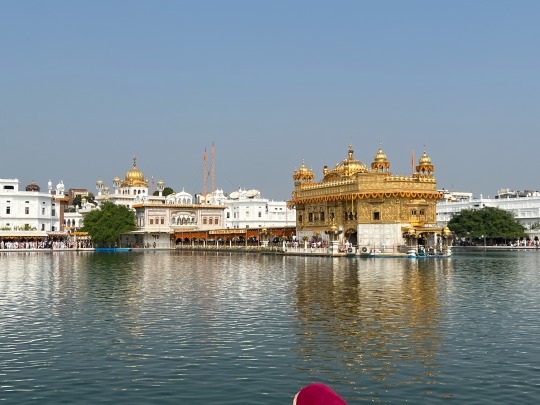
{Pictures by Prabhjot Kaur…}
Harminder Sahib or Darbar Sahib, a gurudwara located in Amritsar, Punjab, India. This is spiritually the most significant shrine in Sikhism.
For some people its just like any other Gurudwara, for some it’s just a tourist place, for some just a shrine, or its just a religious place, for some it’s a place to fill their stomach, for some its a place to stay, for some its place of full of life and people. But for me its not this, for me it’s different.
Being a child in Sikh family who belongs to Amritsar, the heart of Punjab, meaning of Darbar sahib is huge for me. It’s a place to refresh the soul, place where no one will judge you, where no one will ask you for your identity, you can sit anywhere in the Darbar Sahib and get inner peace. The premises of Darbar sahib consists of four doors in four directions which indicates that doors are open for everyone and everyone will be treated same way, no one is special or anything. This is the Highest place in Sikhism, where you’ll see everyone is praying, doing Path (reading holy scripts).
If someone asks me my favourite place? My answer is Darbar Sahib ‘cause it’s not just a place, it’s an emotion which can’t be described in words, you can only feel it. Whenever I visit the place, I get emotional. It seems like it’s the place where you can put your act of being which you do in front of the world and you can be original. The place is full of life, hope, patience, blessings, peace the inner peace and happiness. It’s not only a place of “Bhakti” but also a site of sacrifices which includes the blood of many Sikh’s and Shaheed’s, in which The Battle of Amritsar and operation Blue Star are included, in which more than thousand Sikhs became martyrs. According to Sikhism it’s a story of SABAR, SHUKAR, SIDAK, SIMARN DI MISAAL.
The Darbar sahib doesn’t only stand for religion but the Akaal Takht sahib (in front of Darbar sahib) stands for politics, in significance that religion can’t work without Politics and vice versa. It signifies the life of human, where we learn humanity, love, hope and equality. It’s the highest school of Sikhism.
If someone wants to know what is Sikhism? They should visit Darbar Sahib.
#amritsar#punjabi#punjab#sikhism#sikh#humanity#peace#peaceful#inner peace#photooftheday#photography#darbarsahib#trending#trends#religion#khalsa#goodtimeswithscar
5 notes
·
View notes
Text
A Place to Lay our Heads, and a Long Journey Back to the Beginning
December 21, 2022
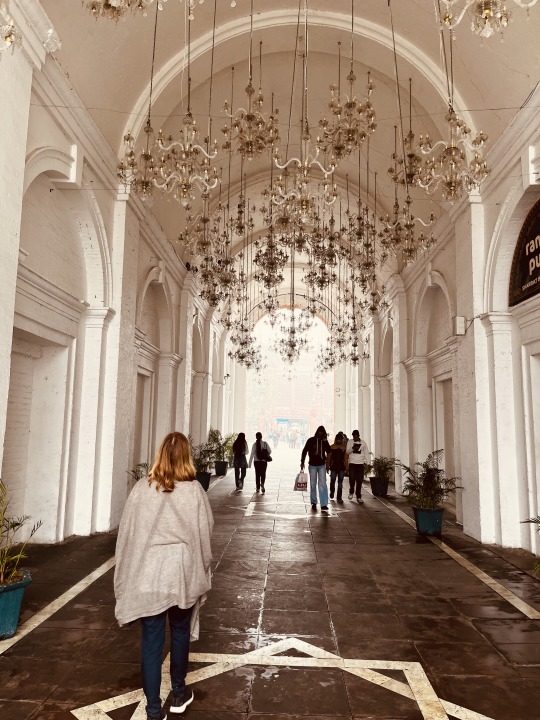
I am having trouble keeping track of the days. I keep thinking it’s Sunday today (and it’s Wednesday), I’m a bit astonished that we’ve been in India a week, and the fact that Christmas is four days away is mind-blowing. Anyone who knows me knows I love this holiday- and I’m getting a little misty thinking about not being with family this year. But this was a conscious choice (in order to meet with my students at Khalsa College and give them an “activity”—I’ve been advised NOT to call it an “assignment”--for over their winter break) and I will relish the chance to experience what Christmas is like in the Punjab. There are certainly signs of the holiday: our hotel is advertising that we can “satiate our Christmas cravings with luscious indulgences, handcrafted by our culinarians”—and for a mere 599 INR (about $7.00) we can have a “Jagermeister Bomb” (don’t know what that is—but yuck.) And there’s an old Anglican church near here from British times with a Christmas Eve service and Christmas day service- so we’ll attend one of those. There are artificial trees for sale in local stalls, along with Santa hats and some other silly stuff—and our hotel has some nice jazz versions of Christmas carols playing (the same playlist over and over…but at least it’s pleasant.) We’ll make our own unique Christmas tradition this year. But I’ll miss the Christmas House in Brookfield, MA where my sister-in-law Margo goes all out in their 18th century home.
The big news since last I wrote is that we found a place to live! David and I were all set to commit to an apartment that was darling—and very comfortable—but in a neighborhood I had some concerns about. In the meanwhile, I reached out to people I met when I was here in 2018—desperately seeking a recommendation for a real estate broker who might help us in our search. One of those people was an astonishing young woman named Aashna Sachdeva whom I had connected with in 2018.
Aashna and me in 2018

Aashna wrote to me Monday morning that her father, whose family had experienced Partition, was touched by the subject of my project, and wanted to help. Within an hour we were visiting a property he owns in a great part of town—and invited to make that our home for the next six months. The place is shared during the day by his partner and crew who are working on developing an app for film editing (it feels like we are in an episode of Silicon Valley minus the obnoxious characters)- but we have a spacious area upstairs. It was pretty sparse when we saw it, but Aashna’s mom Jasmina met me there the next day and made a list of things she could loan us for our stay: a couch, a table, a small frig, some rugs, etc. The generosity of this couple- who were complete strangers to us a week ago-is overwhelming. We move in on Friday- and we’re planning to treat ourselves to a little shopping spree at Home Centre and Fabindia (the temple of my familiar) to make the place feel homey.

This city is fascinating… and intense. Having an oasis of peace will be crucial.
Our new place:

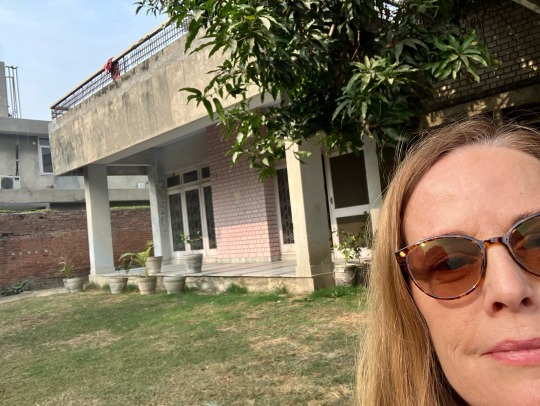
Today, David and I headed to the old city with the plan of visiting the Golden Temple.
On our way
But when we got there, it was teeming with pilgrims, worshippers, and tourists—and we thought it wise to return early one morning or after dark—the times recommended by many. After stopping in at The Partition Museum (the place I visited in 2018 that prompted the whole idea for this Fulbright project),
Outside of the Partition Museum, housed in the old town hall
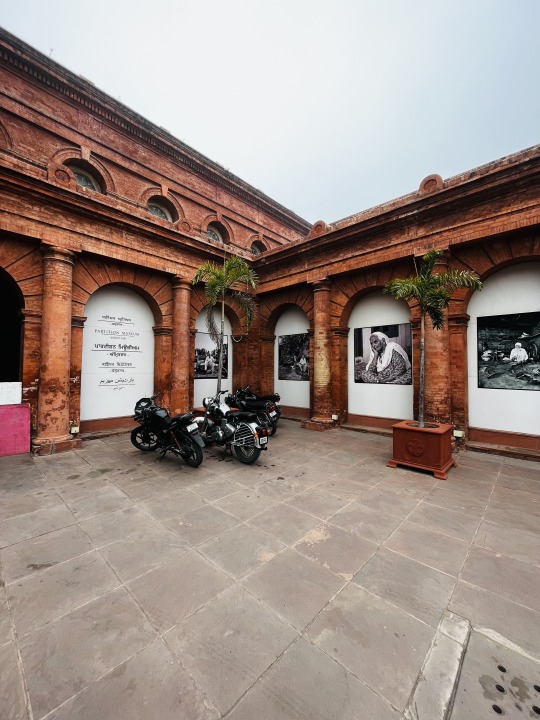

we made our way to the Jallianwala Bagh Memorial. If you don���t know or have forgotten: on April 13, 1919, a group of soldiers commanded by British Brigadier General R.E.H. Dyer entered an enclosed courtyard where a large group of peaceful protesters (men, women, and children) were gathered. He ordered the soldiers (sadly, all Indians serving in the British army) to fire into the crowd. No warning was made to disperse (such gatherings were forbidden)—they just fired –1650 rounds—and killed approximately 1500 men, women, and children. 120 of them jumped into the well in the courtyard to escape the bullets—and all drowned. I’m giving the barest of facts here. But see the scene the scene from “Gandhi” on YouTube below for a pretty accurate (and harrowing) seven-minute depiction (if, perhaps, a little kind to the panel that questioned Dyer later.) You'll see the Town Hall that now houses the Partition Museum in the clip. The space is now a memorial park to the victims and very well done, although the cheery music piped in makes for a bizarre counterpoint to the weight of what took place there.
Jallianwala Bagh

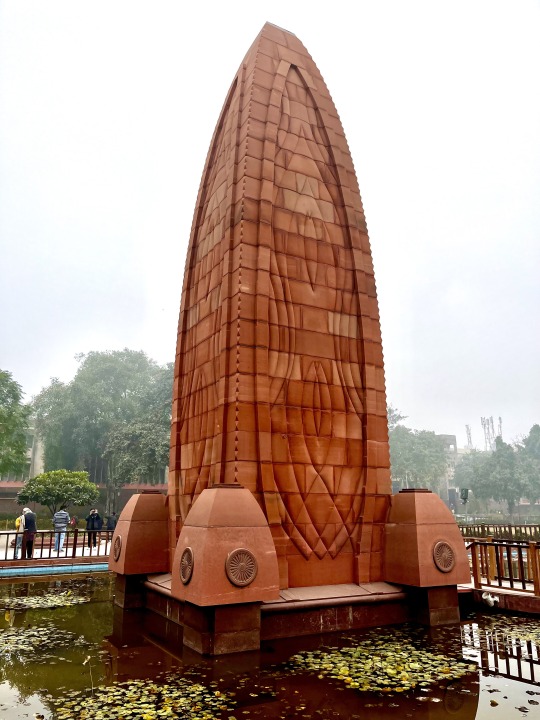
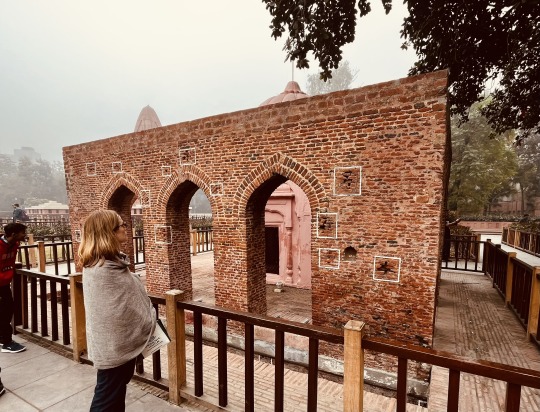

youtube
We were tired after that- and ready to head back to the hotel for a rest. That was not as simple as anticipated. We got ourselves lost in the warren of narrow streets that make up the old city- and my Fitbit knock-off alerted me that I had reached 10,000 steps long before we made it to a main road where we could call an Uber. And that was right back where we’d started. We had walked in a huge, confusing circle—past countless tiny shops, tea stalls and rickshaw drivers all offering to take us where we were going (but none knowing where our hotel was.) Although I had some nervousness that we might get robbed (pick pocketing and other theft are a big problem here)- we both sort of enjoyed the journey. The weather was cool and not unpleasant. There were lots of interesting things to see.

And we knew eventually we’d have to come to something familiar, which we did. It did feel incredibly good to finally climbed into an Uber and sit back as our driver made his way through unimaginable traffic to finally deposit us at our hotel (how does anyone drive in this city?) The Uber cost: 140 INR (about $1.75.) We tipped him more than the ride cost: that price might have been acceptable (for here) if it had been a clear shot—but that poor driver made no money on that ride.
Off to sleep- with the hopes that tonight I don’t wake up at my new time of 1 AM to lie and obsess for an hour before falling back to sleep.
Oh! My funny story of the day: mid-morning I went down to the lobby to ask about extending our stay by one night (the house isn’t quite ready for us.) There was a woman in the lobby impatiently asking for something from the staff. She had on her flannel plaid pajamas and slippers, was holding a cup of chai in each hand, and coughing non-stop. No mask. Not even an attempt to cover her mouth. She then went over to the elevator to head back to her room. I decided to take the stairs. This is a four-star hotel, folks.
And for a little laugh:

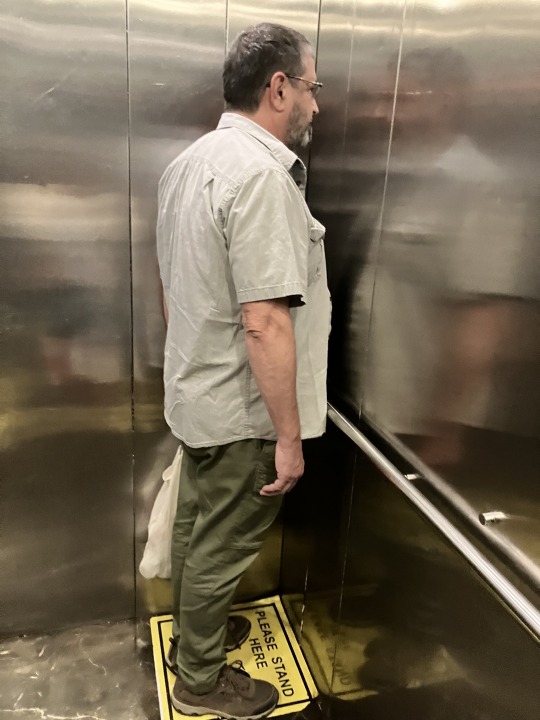
Until the next…
8 notes
·
View notes
Text
Bathinda Fort: The Place where Razia Sultan was held captive
India is a land of diverse cultural heritage, where the remnants of the past still stand tall and proud, bearing testimony to the country’s rich history. One such iconic structure is the Bathinda Fort in Punjab, believed to be the oldest surviving fort in the country. The fort, which dates back to over 1,600 years, is currently undergoing repairs and restoration to preserve its legacy for future generations.
History of Bathinda Fort
The Bathinda Fort has a rich history that dates back to the Kushan era in 100 AD. The fort is believed to have been constructed by Bhatti Rajput rulers during the 6th century. The fort has seen many rulers and empires come and go, including the Guptas, Huns, Mughals, and British, each of whom left their mark on the structure. The fort’s walls, made of clay bricks, are 10 to 12 feet thick, with several bastions spread across the complex. The fort covers an area of about 6 acres, and its main entrance is called the Delhi Gate.
Challenges Faced by the Fort
The Bathinda Fort has faced several challenges over the years. Due to its age, several bastions have collapsed in recent years, posing a threat to the overall structure’s stability. Additionally, the Covid-19 pandemic halted repair work for two years, causing further damage to the fort’s walls and structures.
Restoration Efforts by the Archaeological Survey of India
To preserve the fort’s legacy, the Archaeological Survey of India (ASI) has taken up the task of restoring and repairing the structure. A team of 30 to 40 experts is currently working on the project, using traditional building techniques to maintain the fort’s original character. The ASI has also ensured that the repair work does not damage the fort’s original structure or cause any harm to the environment.
Bathinda Fort: A Popular Tourist Destination
The Bathinda Fort is a popular tourist destination, with more than 4,000 to 5,000 visitors daily. The Gurdwara Qila Mubarak, built in the early 19th century to commemorate the visit of Guru Gobind Singh, is also located within the fort complex, adding to its religious and cultural importance.
Preserving India’s Rich Cultural Heritage
The restoration of the Bathinda Fort is an excellent example of how India is working to preserve its rich cultural heritage for future generations. By investing in the repair and restoration of iconic structures like the Bathinda Fort, India can showcase its rich history and culture to the world. It also ensures that future generations can explore and learn from the past, keeping the country’s cultural legacy alive for years to come.
6 notes
·
View notes
Text
Camel Skin Lamps in Pakistan - Unique and Traditional Lighting
Camel skin lamps are an exquisite example of Pakistan’s rich cultural heritage and traditional craftsmanship. These lamps, crafted from dried camel skin, are not only a source of light but also serve as beautiful art pieces, blending tradition with modern decor. Let's explore the unique and fascinating world of camel skin lamps in Pakistan, and what makes them so special.
A Brief History of Camel Skin Lamps
Camel lamps trace their origins back to the city of Multan, in the southern part of Punjab province. The craft has been practiced for centuries, passed down through generations of artisans. Multan, known as the "City of Saints" and for its vibrant pottery and handicrafts, became a hub for this unique art form, where camel skin was traditionally used to create these luminous decorations.
Historically, camel skin was used in various products, and the idea of using it for lamps emerged as a way to combine function and artistry. The natural texture and durability of camel skin make it ideal for intricate craftsmanship and detailed artwork.
The Crafting Process: A Blend of Art and Skill
The process of making a camel skin lamp is labor-intensive and requires great precision. Artisans first clean and dry the raw camel skin, then stretch it over a wooden frame to form the desired shape of the lamp. The next stage is hand-painting the lamps, which is where the real artistry comes into play.
The designs often depict floral patterns, Islamic geometric motifs, or scenes from local culture. Once the painting is complete, the skin is treated to make it translucent, allowing light to pass through and illuminate the intricate patterns beautifully. Each lamp is handcrafted, meaning no two are exactly the same, adding to their uniqueness.
Steps in the Lamp-Making Process:
Sourcing the Skin:
The skins are ethically sourced from camels that have naturally passed away.
Preparation:
Cleaning and drying the skin to make it suitable for painting and shaping.
Shaping:
The skin is carefully molded around a wooden or metal frame.
Designing:
Hand-painting the designs, often in vibrant colors.
Finishing:
The lamps are treated for durability and translucent effect before being sold or displayed.
Symbolism and Cultural Significance
Camel skin lamps are not just decorative objects; they carry deep cultural significance. In Pakistani households, they are often seen as symbols of heritage, craftsmanship, and a link to ancient traditions. Their warm, soft light is believed to create a peaceful and spiritual ambiance, which is why they are frequently used in religious settings and cultural festivals.
These lamps are also used as gifts, especially during weddings and festive seasons, symbolizing light, warmth, and good fortune. Their connection to the city of Multan adds to their cultural prestige, as owning one is seen as having a piece of Pakistan’s cultural legacy.
Modern Use and Global Appeal
Although rooted in tradition, camel skin lamps have gained international attention for their beauty and uniqueness. In modern times, these lamps are being integrated into contemporary decor settings. Their artistic appeal, combined with the warm glow they emit, makes them ideal for living rooms, bedrooms, or cultural display areas.
The lamps are available in various sizes, from small table lamps to large floor lamps, allowing them to fit into different interior styles. In recent years, artisans have also experimented with more modern designs, blending the traditional craft with current design trends.
Tourists visiting Pakistan often seek out these lamps as souvenirs, and they have also found a place in international art galleries and exhibitions, making them not only a local treasure but a global curiosity.
Challenges Facing the Craft
Despite their appeal, the craft of making camel skin lamps faces several challenges. One of the major issues is the limited number of artisans who continue to practice this age-old craft. As younger generations move toward more industrialized careers, fewer are interested in the traditional handicraft industry.
Another challenge is the ethical sourcing of camel skin. With increasing global awareness around animal rights, artisans must ensure that the materials they use are ethically sourced from animals that have died naturally, rather than through exploitation.
Additionally, competition from mass-produced lighting products poses a threat to the market for handcrafted camel skin lamps. However, there is still hope as interest in preserving traditional crafts and supporting local artisans grows, both in Pakistan and globally.
Conclusion
Camel skin lamps are a testament to Pakistan’s rich cultural history and the skill of its artisans. These lamps, with their intricate designs and warm light, continue to captivate people both locally and internationally. As Pakistan embraces modernity, the preservation of this traditional craft is more important than ever, ensuring that camel skin lamps remain a cherished symbol of Pakistan’s artistic heritage.
Whether used in traditional settings or modern interiors, camel skin lamps stand as a unique fusion of history, art, and light.
for more informationclick here

0 notes
Text
With compliments from, the Directorate General of Public Relations,
Government of the Punjab, Lahore Ph. 99201390
No.1004
HANDOUT (A)
CM Maryam Nawaz Sharif Apprises MPAs of Various Public Welfare Projects of Her Govt
Lahore, 19 September 2024:
“Establish PHA in every city to ensure its beautification,”Chief Minister Punjab Maryam Nawaz Sharif directed the authorities concerned while chairing a meeting of the Assembly Members from Sahiwal Division. She also directed them to restore traditional fairs (Melas) across Punjab, and said,”Administration in every city should encourage and facilitate the local fairs.”
Madam Chief Minister directed IG Police to establish Dolphin force in every city. She also directed the relevant authorities to operationalise cardiology block in Sahiwal as soon as possible, besides meeting the shortage of faculty in Sahiwal Medical College.
Chief Minister Maryam Nawaz Sharif sought a comprehensive plan for the promotion of religious tourism in Pakpattan, and directed the people responsible to complete the construction, repair and decoration of Baba Faridganj Shukar's shrine at the earliest. She also directed the authorities to improve law and order situation in Sahiwal Division.
Madam Chief Minister reviewed a plan for Archaeological Conservation and Tourist Facilitation in Harappa. She directed to set up Model Agri Malls in Sahiwal and Okara. She said,”We are curing the ills of last four to five years.” She added,”Everything is not perfect but it is improving fast.”
Chief Minister Maryam Nawaz Sharif said,”I confess under oath that until today no one has been appointed in the province on anybody’s recommendation.” She added,”Posting in Punjab is being done on merit.”
Madam Chief Minister said,”For the first time in Punjab, a new department is being formally created for the price control.” She added,”Price control committees are being reconstituted to control inflation.” She underscored,”i daily check on a live dashboard rates of food items.” She noted,”Inflation has come down for the first time, it did not happen by itself, rather it is because of our hectic efforts.”
Chief Minister Maryam Nawaz Sharif noted,”It was considered an unpopular decision not to buy wheat, but it has lowered the prices of flour and bread for the people.” She said,”Increase in wheat price does not benefit farmers, but it makes the bread expensive.” She added,”I am not after public appreciation, but trying to make such decisions that put minimum burden on people.” She highlighted,”I don't believe in government rates, bur check the ground facts myself.”
Madam Chief Minister said,”Punjab is the only province where bread is available for Rs 12, 13 and 14.” She added,”We are facing difficulty in making KPI-based score card for Deputy Commissioners.” She explained,”Deputy Commissioner KPI score card includes everything big and small meant for public ease and convenience.”
Chief Minister Maryam Nawaz Sharif highlighted,”Administration takes place in the field from 6, 7 am to late night.” She said,”09 lakh applications have been received for the issuance of Kisan cards.” She added,”The cards will be made active in a few days and a loan of up to Rs 1.5 lakh will be available for a farmer for one cropping season on the card.” She lamented,”Middlemen used to blackmail farmers, some farmers even lost their lives due to this torture.”
Madam Chief Minister said,”We are starting an agricultural graduate internship program to advise farmers on best farming practices.” She added,”We will increase number of houses in ‘Apni Chhat…Aapna Ghar Program’. We will give more than 05 lakh houses.” She flashed,”The first and biggest scheme to provide housing loan on just ownership documents and identity card is being introduced.”
Chief Minister Maryam Nawaz Sharif said,”I have prevented from increasing the monthly installment of ‘Apni Chhat... Apna Ghar Program’ from Rs 14,000.” She added,”Private hospitals and surgeons have been added to the children's heart surgery card.” She apprised the MPAs,”Rs 15,000 will be given after every four months to a deserving disabled on Himat Card.” She further briefed them,”Minority cards will also be issued for widows and poor minority brethren.”
Madam Chief Minister said,”Only Punjab is reducing transport fares due to falling oil prices.” She added,”600 roads are being restored across Punjab, the condition of roads in every city will change in a few months.” She noted,”There was no sanitation system in the whole of Punjab, but now the commissioners have been given a zero waste target.” She said,”They are picking up the dirt lying in streets even for the last 10 years.” She added,”Police officers have been instructed to go to mosques for the convenience of people.”
The visiting Assembly Members said,”Inflation is decreasing, Chief Minister Maryam Nawaz Sharif is doing a remarkable work.” They added,”Pakistan Muslim League (N) is a true sympathizer and benefactor of the farmers.” They noted,”For the first time, people's money is being spent on public projects, we appreciate the Chief Minister for bringing public welfare project to ensure ease and welfare of people.” They also thanked Madam Chief Minister for building roads of Sahiwal Division.
Senator Pervaiz Rashid, Senior Provincial Minister Marriyum Aurangzeb, Information & Culture Minister Azma Zahid Bukhari, SACM Zeeshan Malik and Members of the Provincial Assembly attended the meeting. Chief Secretary, IG Police, Chairman P&D, Commissioner Sahiwal Shoaib Iqbal Syed, RPO, DC and other relevant officers were also present.
*****
0 notes
Text
Best Local Cuisine in Chandigarh to Manali Tour

Are you going on a long weekend in Chandigarh, Shimla and Manali? These three spots are not just tourist attractions but for us, those three places are the best option for weekends. If you are going on a Shimla Manali Tour by Car, you can take a rest and try local cuisine in the places mentioned below.
Chandigarh
Pal Dhaba - It is famous for its Punjabi thali and North Indian food.
Indian Coffee House – Indian Coffee House is popular for its South Indian cuisine.
Gopal’s House – It is famous for its North Indian thali and Chole Bhature, which you should not miss.
Shimla
Wake and Bake Café – It is popular for its Tibetan food like Momo and Thukpa.
Ashiana and Goofa – It is famous for its Himachal cuisine like Chana Madra.
Baljee’s – It is famous for its Himachal famous dish siddu and local sweets.
Manali
The Lazy Dog – The Lazy Dog specializes not only in local cuisine for also famous for its international cuisine.
Café 1947 – It is popular for its live music and Italian cuisine like Pizza.
Sher-E-Punjab – A popular restaurant for North Indian food, mainly Punjabi cuisine.
Visiting those places will ensure to give you a wonderful food experience during the journey.
0 notes
Link
Tourist Places in Punjab
Mostly people start to looking for tourist destinations when weather changes to summer. Let's talk about some places to visit in Punjab where you can enjoy your vacations.
0 notes
Text
Discover Nangal's Hidden Gems: Explore with the Eco-Friendly Cycling Community
Nangal, a charming town nestled in the foothills of the Shivalik range, is a hidden paradise waiting to be explored. While it's known for its scenic beauty and the Bhakra-Nangal Dam, there are lesser-known spots that offer a unique and tranquil experience. And what better way to explore the Top Hidden Places in Nangal
then by joining Nangal By Cycle, an eco-friendly cycling community committed to sustainable tourism?
1. Ramgarh Fort: A Historical Marvel
Hidden away from the usual tourist routes, Ramgarh Fort is a historical gem that offers a glimpse into the region's rich past. The fort, though in ruins, still exudes a certain grandeur that transports you back in time. Cycling to this spot early in the morning gives you the chance to soak in the history while enjoying the fresh, crisp air. Plus, the fort's location offers a panoramic view of the surrounding hills, making it a perfect spot for photography enthusiasts.
2. Purana Mandir: A Spiritual Retreat
The Purana Mandir, an ancient temple tucked away in a secluded part of Nangal, is another hidden treasure. Surrounded by dense trees and a serene atmosphere, this temple is perfect for those looking to meditate or simply enjoy some quiet time. Cycling through the narrow lanes leading to the temple adds to the experience, allowing you to connect with nature and spirituality simultaneously.
3. Eco Park: Nature’s Playground
For those who love being surrounded by nature, Eco Park is a must-visit. This park is relatively unknown to many, but it's a favorite among the locals. With lush greenery, well-maintained paths, and a tranquil lake, it’s a cyclist's dream come true. The park also emphasizes eco-friendly practices, making it a great place for the Nangal By Cycle community to promote sustainable living.
4. Chhota Nangal: A Scenic Village
A short ride from the main town, Chhota Nangal is a picturesque village that remains untouched by urbanization. The village offers a glimpse into the traditional way of life, with its quaint houses, friendly locals, and expansive fields. Cycling through this village allows you to experience the authentic rural charm of Punjab, all while supporting eco-friendly travel.
5. Bhakra Canal: A Serene Cycling Route
The Bhakra Canal, with its calm waters and scenic views, provides an ideal route for a peaceful cycling journey. The path alongside the canal is perfect for a leisurely ride, offering glimpses of local wildlife and stunning sunsets. It's a spot where you can truly unwind and reconnect with nature.
Join the Nangal By Cycle Community
Exploring Nangal's hidden places on a cycle not only offers a unique perspective but also promotes a healthier and more sustainable way of traveling. The Nangal By Cycle community is dedicated to preserving the natural beauty of the region by encouraging eco-friendly practices among its members.
So, grab your helmet, hop on your cycle, and discover the hidden gems of Nangal with us. Together, we can create a greener and more beautiful world, one pedal at a time.
0 notes
Text
youtube
Shalimaarbagh Garden Kapurthala City.
#shalimaarbagh#shalimaar#kapurthala#punjab#india#vlogging#vlogger#daily vlog#tourist#place#tourism#Youtube
0 notes
Text
Sacred Places to Visit in India for a Spiritual Journey

India is known worldwide as a land of spirituality, mysticism, and religious diversity. For centuries, it has been a destination for seekers of enlightenment, peace, and spiritual growth. Whether you are looking to explore ancient temples, join meditative practices, or immerse yourself in the vibrant culture, India offers countless sacred places that provide a deep sense of serenity and spirituality. Here’s a list of the most sacred places to visit in India for an unforgettable spiritual journey.
1. Varanasi – The Spiritual Heart of India
Location: Uttar Pradesh
Best Time to Visit: October to March
Varanasi, also known as Kashi or Benares, is one of the oldest inhabited cities in the world and is regarded as the spiritual capital of India. Situated on the banks of the holy River Ganges, Varanasi is a significant pilgrimage site for Hindus, who believe that bathing in the river can cleanse sins and lead to salvation.
Highlights: Witness the mesmerizing Ganga Aarti at Dashashwamedh Ghat, take a boat ride along the river at sunrise, and explore the narrow alleys filled with temples, ashrams, and local markets.
Spiritual Experience: Participate in the rituals and ceremonies along the ghats, or spend time in quiet reflection by the river.
Insert Backlink Here: Varanasi is a must-visit for any spiritual journey in India. For more destinations that will enrich your travel experience, check out our guide on the Top 10 Places to Visit in India.
2. Rishikesh – The Yoga Capital of the World
Location: Uttarakhand
Best Time to Visit: September to June
Nestled in the foothills of the Himalayas, Rishikesh is known as the yoga capital of the world. It is a hub for spirituality and adventure, attracting travelers seeking inner peace and rejuvenation through yoga and meditation.
Highlights: Visit the ancient ashrams like Parmarth Niketan and Swarg Ashram, attend yoga classes and meditation sessions, and explore the iconic Laxman Jhula and Ram Jhula bridges.
Spiritual Experience: Engage in yoga and meditation retreats, attend satsangs (spiritual discourses), or simply soak in the serene atmosphere by the Ganges.
3. Bodh Gaya – The Land of Enlightenment
Location: Bihar
Best Time to Visit: October to March
Bodh Gaya is one of the most significant pilgrimage sites for Buddhists. It is here that Prince Siddhartha Gautama attained enlightenment under the Bodhi Tree and became the Buddha. The Mahabodhi Temple complex, a UNESCO World Heritage site, attracts devotees and tourists from around the world.
Highlights: Visit the Mahabodhi Temple, meditate under the Bodhi Tree, and explore nearby monasteries built by Buddhist communities from different countries.
Spiritual Experience: Engage in meditation practices and listen to teachings from Buddhist monks at various monasteries.
4. Amritsar – The Spiritual and Cultural Hub of Sikhism
Location: Punjab
Best Time to Visit: November to March
Amritsar, the spiritual and cultural center of Sikhism, is home to the Golden Temple (Harmandir Sahib), one of the most revered shrines in India. The temple’s stunning golden architecture, set amidst a sacred pool, and the community service at the langar (community kitchen) reflect the Sikh principles of equality and selfless service.
Highlights: Visit the Golden Temple, participate in the langar, and witness the evening Palki Sahib ceremony.
Spiritual Experience: Immerse yourself in the temple's serene environment and experience the power of devotion and community service.
5. Tirupati – The Abode of Lord Venkateswara
Location: Andhra Pradesh
Best Time to Visit: September to March
Tirupati is home to the Tirumala Venkateswara Temple, one of the most famous and richest temples in the world. Dedicated to Lord Venkateswara (a form of Vishnu), the temple attracts millions of pilgrims each year, making it one of the most-visited religious sites globally.
Highlights: Seek blessings at the Tirumala Temple, explore the nearby Kapila Theertham and Talakona Waterfall, and participate in the temple's rituals.
Spiritual Experience: Feel the divine energy while standing in line for darshan (viewing of the deity) and experience the devotion of the pilgrims.
Insert Backlink Here: Tirupati offers a profound spiritual experience. To explore more of India’s sacred sites and other top destinations, read our Top 10 Places to Visit in India.
6. Haridwar – Gateway to the Gods
Location: Uttarakhand
Best Time to Visit: February to April, August to October
Haridwar, meaning "Gateway to the Gods," is one of the holiest cities in India. Situated at the point where the Ganges leaves the mountains and enters the plains, it is an important pilgrimage site for Hindus. The Kumbh Mela, the world’s largest religious gathering, is held here every 12 years.
Highlights: Attend the Ganga Aarti at Har Ki Pauri, visit the Chandi Devi and Mansa Devi Temples, and explore the ghats along the Ganges.
Spiritual Experience: Participate in the Ganga Aarti and dip in the holy Ganges to cleanse your soul.
7. Shirdi – The Land of Sai Baba
Location: Maharashtra
Best Time to Visit: December to February
Shirdi is a small town known for the Shirdi Sai Baba Temple, dedicated to Sai Baba, a revered spiritual leader who preached love, forgiveness, and charity. The temple complex attracts millions of devotees seeking blessings and solace.
Highlights: Visit the Sai Baba Temple, attend the Kakad Aarti (morning prayer), and explore the Dwarkamai and Chavadi, places associated with Sai Baba's life.
Spiritual Experience: Experience the tranquil environment of the temple and join in the various aartis and bhajans (devotional songs).
8. Puri – The Sacred Coastal Town
Location: Odisha
Best Time to Visit: November to February
Puri is a coastal town known for the Jagannath Temple, one of the Char Dham (four sacred abodes) pilgrimage sites for Hindus. The annual Rath Yatra (chariot festival) draws thousands of devotees from all over the country.
Highlights: Visit the Jagannath Temple, attend the Rath Yatra, and relax on Puri’s golden beaches.
Spiritual Experience: Witness the fervor of the Rath Yatra and experience the devotion of the pilgrims.
9. Kedarnath – A Remote Pilgrimage in the Himalayas
Location: Uttarakhand
Best Time to Visit: May to June and September to October
Kedarnath is one of the most important temples dedicated to Lord Shiva and is part of the Char Dham pilgrimage in Uttarakhand. Located in the Garhwal Himalayas, reaching Kedarnath requires a trek through breathtaking landscapes.
Highlights: Visit the Kedarnath Temple, trek through the scenic routes, and explore the surrounding mountains.
Spiritual Experience: Undertake the challenging trek to the temple, a journey that is both physically and spiritually rewarding.
10. Vaishno Devi – A Holy Shrine in the Trikuta Mountains
Location: Jammu and Kashmir
Best Time to Visit: March to October
Vaishno Devi is one of the most revered Hindu pilgrimage destinations, dedicated to the goddess Vaishno Devi. The temple is located in a cave atop the Trikuta Mountains and requires a trek of about 13 kilometers from the base camp at Katra.
Highlights: Trek to the Vaishno Devi Temple, visit the Bhairon Temple, and enjoy the scenic views of the Trikuta Mountains.
Spiritual Experience: The journey to the temple is believed to cleanse the soul and fulfill the wishes of the devotees.
Insert Backlink Here: Vaishno Devi offers a deeply spiritual experience. For more sacred places and top destinations in India, take a look at our Top 10 Places to Visit in India.
Conclusion
India’s sacred places offer more than just religious significance; they provide a deep sense of peace, spirituality, and connection to the divine. Whether you are a pilgrim or a traveler seeking spiritual enrichment, these destinations offer experiences that are both profound and transformative.
Embark on a spiritual journey and explore the divine energy of these sacred places. To discover more beautiful and spiritually uplifting destinations, don’t forget to check out our Top 10 Places to Visit in India.
1 note
·
View note
Text
Top Five Historical Places In Punjab | Major tourist places in Punjab

0 notes